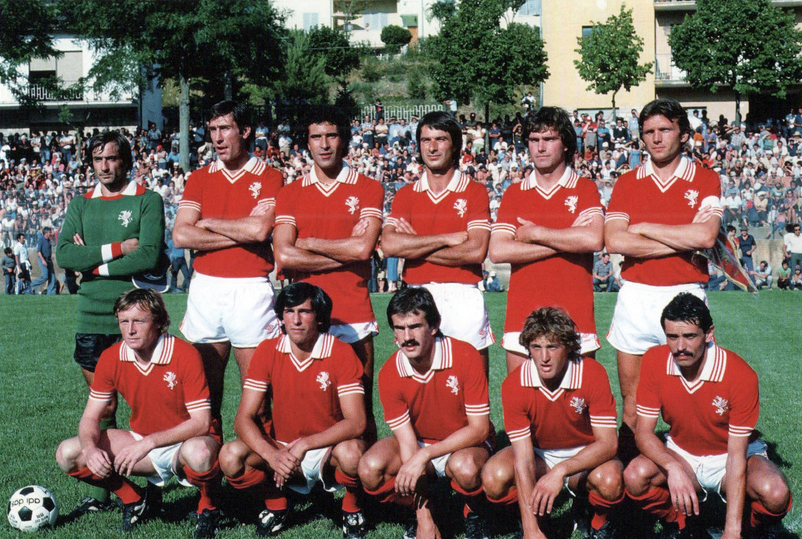As the capital of Umbria, Perugia has a rich history dating back to the Etruscan period. The River Tiber flows through the city, renowned as one of the cultural and artistic centres of Italy as well as its universities. The city’s football club, AC Perugia, have endured mixed fortunes however during the 1978-79 season they threatened to challenge the Italian football hierarchy, pushing AC Milan to the wire in an enthralling title race which saw the Grifoni (Griffins) become indomitable.
AC Perugia was formed in June 1905, following the merger of U.S. Fortebraccio and Libertas. Initially residing in the lower leagues, Perugia achieved promotion to Serie B in 1966. The turning point in their history came in 1974 when Franco D’Attoma became club president. D’Attoma came from a wealthy family in Apulia but fell in love with Perugia while studying at university, adopting the city as his second home and marrying into the Servadio family, who owned the Ellesse clothing company.
Upon D’Attoma’s arrival at Perugia, a 34-year-old coach by the name of Ilario Castagner had taken charge. The young tactician immediately set about instilling his own ideas and training methods. His pioneering ideas brought instant success. A season later, Perugia achieved promotion to Serie A for the first time in their history.
During their first season in Italy’s top flight they achieved a credible eighth place finish. This was built upon the following season after the Grifoni came sixth and qualified for the Coppa Mitropa. However Perugia’s progression was marred by tragedy after midfielder Renato Curi died on October 30, 1977. Curi collapsed midway through a home game against Juventus after suffering a heart attack. In honour of his memory the clubs stadium was named after the midfielder and the Stadio Renato Curi remains Perugia’s home today.
The poignant events seemed to galvanise the squad and the following campaign, Perugia would launch an assault on the Serie A title. During the historic 1978-79 season, Castagner used a 1-3-2-3-1 formation in which club captain, Pierluigi Frosio, sat in front of goalkeeper Nello Malizia in a sweeper position. Playing as a ‘libero’, Frosio was given this role to deal with any balls that breached the defensive line of three sitting in front of him. This trio usually consisted of Michele Nappi, Mauro Della Martira and Antonio Ceccarini. Marco Vannini was the anchor in the midfield with Salvatore Bagni and Walter Speggiorin providing width. Castagner claimed the system was based on that of Dutch giants Ajax. It was a formation that allowed sweeper Frosio the freedom to join in with the midfield which pushed Gianfranco Casarsa forward to occupy a deep lying centre-forward position.
Castagner had made his team hard to beat but deficiencies in the goal scoring department would ultimately cost his team. Despite going undefeated for a season, becoming Italy’s first ‘invincibles’ – an accolade usually associated with Fabio Capello’s AC Milan side of the 1991-92 season – Perugia failed to win the Scudetto. The Grifoni managed 19 draws and 11 wins in a Serie A which consisted of 16 teams.
The first half of the season went well, with the stand out result being a 2-1 away win at reigning champions Juventus. The title race soon developed into a two horse race between Perugia and AC Milan.
However Perugia’s struggles in front of goal started to take their toll and a run of six draws in seven games allowed the Rossoneri to remain in touching distance. Injuries in the second half of the season proved the turning point. First, Castagner’s protagonist in the centre of midfield, Vannini, suffered a career ending injury following a horrific tackle from Inter’s Adriano Fedele. A double fracture of the tibia and fibula ensured Vannini would never play again. The Umbrian’s captain Frosio also missed a host of games during the second half of the season through injury, but Castagner’s men managed to stay in Scudetto contention throughout the campaign.
Their title ambitions were eventually put to bed on the penultimate weekend. Perugia needed to beat Lazio and hope for a Milan defeat away to Bologna and while a 2-0 win over the Capital club kept Perugia’s hopes alive, the Rossoneri secured the point they required with a goalless draw at the Stadio Renato Dall’Ara. The dream was over for the Grifoni but they still had their unbeaten record to play for in the last game of the season. A draw with Bologna ensured the team remained ‘invicible’ and secured qualification for next season’s UEFA cup. It was scant reward for such a remarkable achievement. But it was a historic season for the Umbrian’s nonetheless.
Mid-table mediocrity followed as Perugia finished eighth a season later. The Totonero scandal (a match fixing scandal involving numerous clubs and players, notably Paolo Rossi) spelled an end to Perugia’s golden period as the team were hit with a 5-point deduction and were subsequently relegated n in 1981.
They plummeted as far down as Serie C2 (What was then Italy’s last tier of professional football) before a mini revival saw Perugia return to Serie A for the 1995-96 season. The 2000s saw a reprieve for the club as they spent six seasons in Italy’s top flight but they failed to come anywhere close to reaching the heights Castagner’s men scaled.
Perugia’s remarkable achievement will probably never get the recognition it deserves, predominately because history doesn’t remember teams who come in second place. But it took the might of Milan to match their invincible feat and that in itself is a major compliment.

